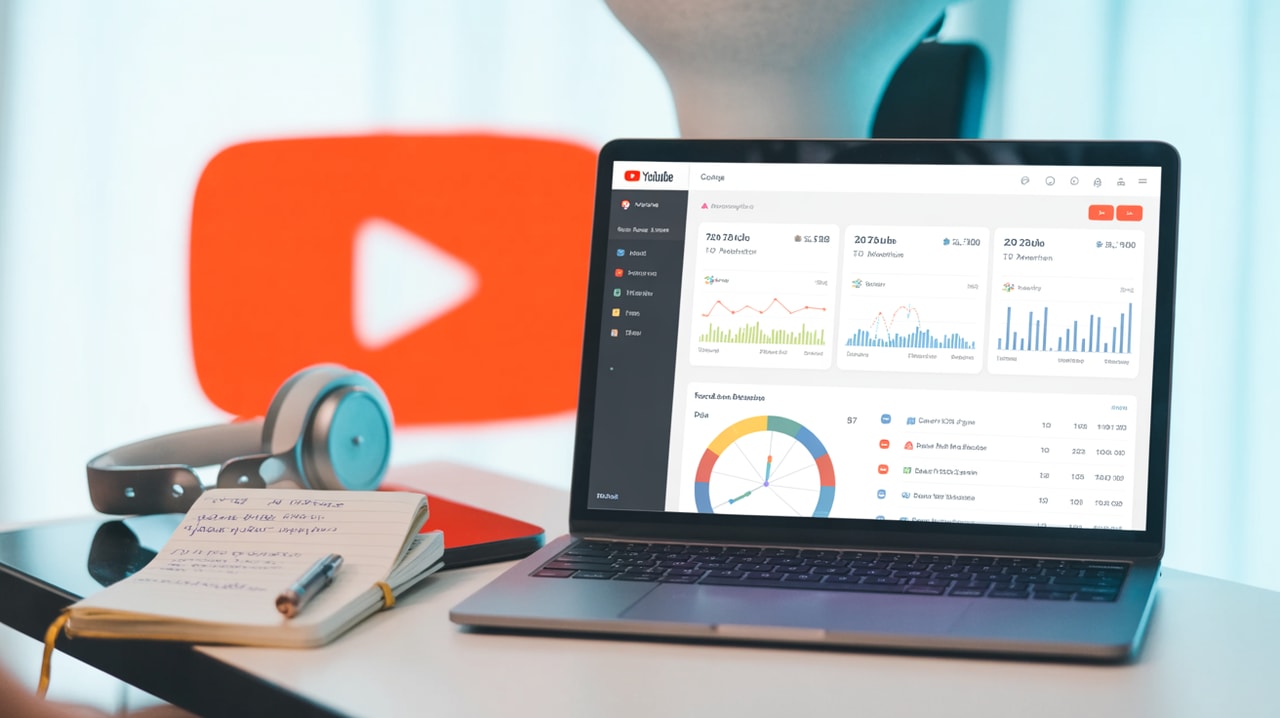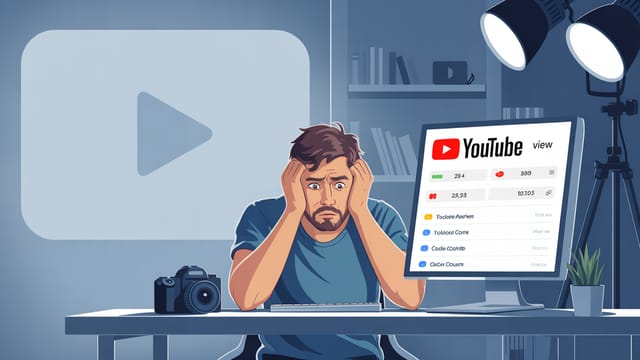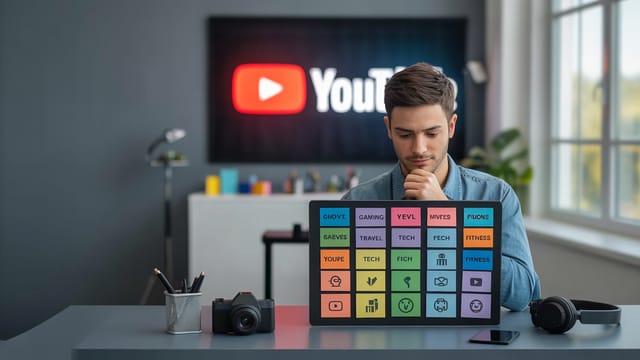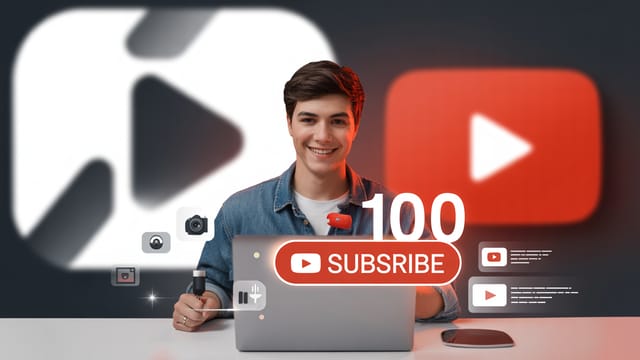
Ready to get your next 10,000 subscribers?
Join thousands of creators who use Subscribr to create faster, better YouTube videos.
Stop guessing! Learn how to use your YouTube analytics to find video ideas your audience loves and that drive channel growth.
Why Your Analytics Hold the Key to Your Next Viral Video
Feeling stuck for video ideas? You're not alone. Many creators struggle to consistently come up with content that resonates with their audience and performs well. The good news? The answers are already waiting for you, hidden within your YouTube Analytics.
Think of your analytics as a direct line to your viewers' brains. They show you what people are watching, how long they're watching it, how they found you, and even what else they're interested in on YouTube. Learning to translate this raw data into actionable insights is the single most powerful way to overcome creative blocks and ensure your content strategy is audience-centric.
For intermediate creators, moving beyond basic view counts is crucial. This article will guide you through using key analytics reports to uncover hidden opportunities, understand exactly what your audience craves, and build a content strategy based on real data, not just guesswork. This data-driven approach not only makes finding ideas easier but also directly impacts your channel's performance metrics like views, watch time, and click-through rate (CTR), ultimately boosting your ad revenue and growth.
What YouTube Analytics Should You Look At for Video Ideas?
Your YouTube Studio provides a wealth of data, but it's easy to get overwhelmed. To find video ideas, focus on these specific reports:
The Audience Tab: Understanding Who's Watching and What Else They Like
This is arguably the most valuable section for generating new video ideas.
- Other Channels Your Audience Watches: This report shows you channels that your viewers also subscribe to or watch regularly. This is pure gold! It reveals adjacent topics or niches your audience is interested in but which you might not be covering yet. If your cooking audience is also watching gardening channels, maybe a video about growing your own herbs for recipes is a great idea.
- Other Videos Your Audience Watches: Similar to the above, but focuses on specific videos. Look for patterns in the types of videos or topics that appear here. Are there formats you haven't tried? Are there specific problems these videos solve that you could address from your unique perspective?
- When Your Audience is on YouTube: While this primarily helps with scheduling, understanding when your viewers are most active can inform the type of content you promote during those peak times (e.g., premieres, community posts).
- New vs. Returning Viewers: Analyzing the retention of new versus returning viewers can tell you if certain topics or video styles are better at attracting new people or keeping your core community engaged. This helps tailor content goals – are you trying to expand your reach or deepen engagement with existing fans?
The Research Tab: Tapping into Search Demand
Located within YouTube Studio, the Research tab helps you explore search terms viewers are using on YouTube.
- Searches on YouTube: This shows you popular keywords and topics related to your channel and audience. Look for terms with high search volume but potentially lower competition. This can reveal underserved areas where you can create videos that directly answer viewer questions.
- Your Viewers' Searches: Even more powerful, this section shows the actual terms your audience used to find videos on YouTube in the last 28 days. Every single query listed here is a potential video title or topic! This eliminates guesswork about what your specific viewers are looking for.
- Searches Across YouTube: Explore popular topics beyond your immediate niche to find broader trends or related areas that might intersect with your content.
Content Tab: Analyzing Performance Patterns
This is where you see how your own videos are performing.
- Top Content: Look at your best-performing videos over different time periods (last 28 days, 90 days, lifetime). What do they have in common?
- Topics: Is there a specific topic that consistently gets more views?
- Formats: Do tutorials outperform vlogs? Are short, punchy videos better than long, in-depth ones?
- Titles & Thumbnails: What kind of packaging leads to higher CTR?
- Hooks: How did you start these successful videos? Success leaves clues. Identify the patterns in your winners and create more content like that.
- Least Performing Content: Don't just ignore videos that flopped. Analyze them. What was different? Was the topic less interesting to your audience? Was the title confusing? Was the video too long or too short? Learning from your less successful videos is just as important as learning from your hits.
- Key Moments for Audience Retention: This is a graph on each video's analytics page showing when viewers watch and when they drop off.
- Spikes: Identify moments where retention increases. What were you talking about or showing right then? These are topics or segments that strongly resonated and could be expanded into their own dedicated videos.
- Dips: Note where viewers leave in large numbers. Was there a confusing explanation, a boring section, or a technical issue? Understanding drop-off points helps you improve your scripting and editing. Analyzing the first 30 seconds is crucial – a big drop here means your hook isn't working.
Traffic Sources: Where Viewers Come From
Understanding how viewers find you provides context for why certain videos perform well.
- YouTube Search: As mentioned in the Research tab, the specific queries here are direct video ideas.
- Suggested Videos: Which videos are leading people to yours? This indicates topics or channels that YouTube's algorithm sees as related and potentially relevant to your viewers. Creating content similar to the videos that suggest yours can tap into existing viewer journeys.
How Do I Find Out Exactly What My Audience Wants to Watch?
Beyond just looking at numbers, truly understanding your audience requires deeper analysis and engagement.
- Analyze "Other Channels/Videos": As discussed, this report in the Audience tab is a direct window into their broader interests. Don't just note the channel names; watch some of their popular videos. What problems are they solving? What's their style?
- Mine the Research Tab: Your viewers' search terms are explicit statements of what they want to find on YouTube. Prioritize creating videos that directly answer these search queries.
- Read and Respond to Comments: Your comments section is a goldmine of feedback, questions, and ideas. Pay attention to:
- Questions viewers ask – these are often unmet needs.
- Suggestions for future videos.
- Common pain points or challenges they mention.
- Positive feedback on specific segments or topics within your videos.
- Use Community Polls and Posts: Directly ask your audience what they want to see next. Give them options based on your analytics research. This not only provides ideas but also boosts engagement and makes your audience feel heard.
- Analyze Retention Spikes: Go back to your high-retention moments. What about those specific topics or explanations resonated so strongly? Can you create entire videos expanding on those points?
- Look at External Trends (Carefully): While not purely analytics, understanding broader trends in your niche (using the Research tab or general web search) can help you connect audience interests to timely topics. However, always filter these trends through the lens of "Does my specific audience care about this?"
Subscribr Tip: Subscribr's Audience Persona generation and Channel Intelligence system can help you visualize and understand your target demographic based on your linked channel's data, making it easier to tailor content ideas specifically to them.
How Can Analytics Improve My CTR?
Click-Through Rate (CTR) is the percentage of people who see your thumbnail and title on YouTube (in search results, suggested videos, homepage, etc.) and click on it. A higher CTR means more people are choosing your video over others. Analytics are crucial for improving it:
- Identify Your High-CTR Videos: In your Content tab, look at the "Impressions click-through rate" metric. Sort your videos to see which ones have the highest CTR (for videos with a decent number of impressions).
- Analyze Their Packaging: Once you've identified high-CTR videos, study their titles and thumbnails.
- Titles: Are they benefit-driven? Do they create curiosity? Are they clear and concise? Do they use specific keywords?
- Thumbnails: Are they visually clear? Do they use strong colors or graphics? Do they feature faces? Is the text readable? Do they accurately represent the video content?
- Identify Your Low-CTR Videos: Also look at videos with low CTR. Compare their titles and thumbnails to your high performers. What's missing? Are they generic? Are they misleading? Are they visually unappealing or hard to read?
- A/B Test (with enough data): If you have enough impressions on similar videos, you can experiment with different thumbnail and title combinations to see which performs better. YouTube Studio sometimes offers built-in A/B testing features, or you can manually test by changing packaging after a few days and comparing performance.
- Ensure Title & Thumbnail Match Content: A high CTR is useless if viewers immediately leave because the video didn't deliver on the promise of the title and thumbnail. Use analytics (specifically Audience Retention in the first 30 seconds) to see if videos with high CTR also have good initial retention. If not, your packaging might be clickbait, which hurts your channel in the long run.
Subscribr Tip: Subscribr's Thumbnail Brief Creator and Title Generation System use AI trained on YouTube data to help you create optimized packaging based on proven patterns, directly supporting your efforts to improve CTR. The platform's Video Breakdown Tool can also analyze successful videos to identify common thumbnail styles and title formats in your niche.
Turning Analytics into Action: Building Your Content Strategy
Now that you know which analytics to look at and how to interpret them, let's put it into practice.
- Regular Review Schedule: Set aside dedicated time each week or month to dive into your analytics. Don't just glance at the dashboard; go into the detailed reports.
- Identify Patterns, Not Just Numbers: Look for recurring themes across your successful videos, your audience's interests, and search queries. Are there topics that keep coming up? Formats that consistently perform?
- Brainstorm Based on Insights: Use the patterns you found to brainstorm new video ideas. If your audience loves your tutorial series and is searching for "how to do X," your next video idea is clear! If they're watching channels about topic Y, think about how you can create content on topic Y from your unique perspective.
- Prioritize Ideas: You'll likely find dozens of potential ideas. Prioritize those that align with:
- Your channel's niche and expertise.
- Strong audience interest (from Audience tab and Research tab).
- Proven performance patterns on your own channel (from Content tab).
- Topics where you can provide unique value.
- Plan Your Content Calendar: Schedule your prioritized ideas. Think about how they fit together and how you can create series or follow-up videos based on successful themes.
- Use Research Tools: Before scripting, use tools like Subscribr's Research Assistant or YouTube's own Research tab to gather more information on the topic and see what existing content is out there. How can you make yours better or different?
- Create with Data in Mind: As you script and edit, remember the retention data. Structure your video to keep viewers engaged, putting the most compelling information upfront and throughout. Ensure your hook is strong based on what you learned from your high-retention videos.
- Optimize Packaging: Based on your CTR analysis, craft compelling titles and thumbnails that accurately represent your video and entice clicks.
- Analyze Again: After publishing, go back to analytics. How did the new video perform? Did it meet your expectations based on your research? Use its data to inform your next video idea. This creates a continuous feedback loop.
This data-driven cycle of analyze, brainstorm, create, and analyze again is the engine of sustainable YouTube growth. It takes the guesswork out of content creation and ensures you're always making videos that your audience is most likely to watch, boosting watch time and directly impacting your channel's monetization and algorithmic performance.
Tools & Resources
Leveraging the right tools can make this process much more efficient.
- YouTube Studio / YouTube Analytics: Your primary source of data. Spend time exploring every report mentioned in this article.
- Subscribr: A comprehensive platform designed specifically for YouTube creators. Use Subscribr's Channel Intelligence to get a holistic view of your performance, the Research Assistant to gather information for new ideas, the Video Analysis Suite to break down successful content structures, and the AI Script Writer to turn your data-backed ideas into compelling scripts. Subscribr helps streamline the entire data-driven content workflow from idea to finished video. You can learn more at Subscribr.
Conclusion
Stop staring at a blank screen wondering what to film next. Your YouTube analytics are a powerful, free resource waiting to be unlocked. By regularly diving into the Audience, Research, Content, and Traffic Source tabs, you gain invaluable insights into what your viewers want, what performs well on your channel, and how people are finding your content.
Translating these insights into actionable video ideas and optimizing your content based on real performance data is the hallmark of a data-driven creator. This approach not only makes ideation easier but also builds a stronger connection with your audience and significantly improves your channel's growth, view counts, and ultimately, your earning potential. Start making analytics a non-negotiable part of your creative process today, and watch how it transforms your channel.





